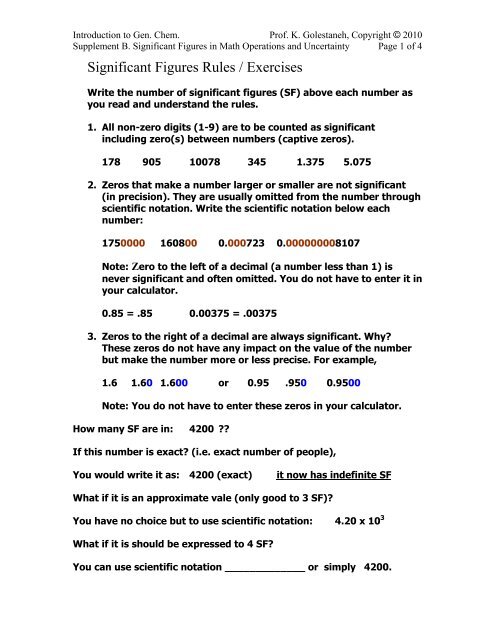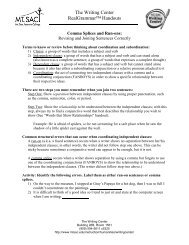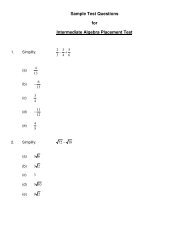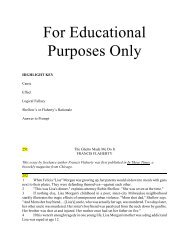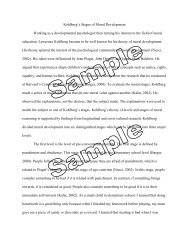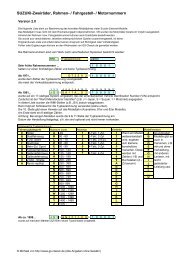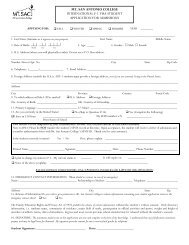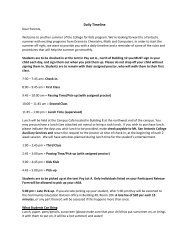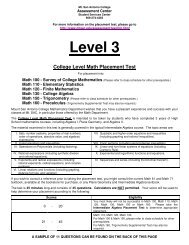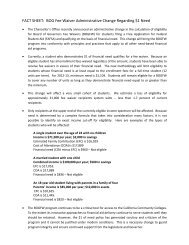Significant Figures Rules / Exercises
Significant Figures Rules / Exercises
Significant Figures Rules / Exercises
Create successful ePaper yourself
Turn your PDF publications into a flip-book with our unique Google optimized e-Paper software.
Introduction to Gen. Chem. Prof. K. Golestaneh, Copyright © 2010<br />
Supplement B. <strong>Significant</strong> <strong>Figures</strong> in Math Operations and Uncertainty Page 1 of 4<br />
<strong>Significant</strong> <strong>Figures</strong> <strong>Rules</strong> / <strong>Exercises</strong><br />
Write the number of significant figures (SF) above each number as<br />
you read and understand the rules.<br />
1. All non-zero digits (1-9) are to be counted as significant<br />
including zero(s) between numbers (captive zeros).<br />
178 905 10078 345 1.375 5.075<br />
2. Zeros that make a number larger or smaller are not significant<br />
(in precision). They are usually omitted from the number through<br />
scientific notation. Write the scientific notation below each<br />
number:<br />
1750000 160800 0.000723 0.000000008107<br />
Note: Zero to the left of a decimal (a number less than 1) is<br />
never significant and often omitted. You do not have to enter it in<br />
your calculator.<br />
0.85 = .85 0.00375 = .00375<br />
3. Zeros to the right of a decimal are always significant. Why?<br />
These zeros do not have any impact on the value of the number<br />
but make the number more or less precise. For example,<br />
1.6 1.60 1.600 or 0.95 .950 0.9500<br />
Note: You do not have to enter these zeros in your calculator.<br />
How many SF are in: 4200 ??<br />
If this number is exact? (i.e. exact number of people),<br />
You would write it as: 4200 (exact)<br />
it now has indefinite SF<br />
What if it is an approximate vale (only good to 3 SF)?<br />
You have no choice but to use scientific notation: 4.20 x 10 3<br />
What if it is should be expressed to 4 SF?<br />
You can use scientific notation _____________ or simply 4200.
Introduction to Gen. Chem. Prof. K. Golestaneh, Copyright © 2010<br />
Supplement B. <strong>Significant</strong> <strong>Figures</strong> in Math Operations and Uncertainty Page 2 of 4<br />
Note : Placing a decimal after these zeros will not change the value of<br />
the number (you do not have to enter it in your calculator) but makes<br />
the zeros captive and they count toward SF.<br />
Example: Write 5000 to 2 SF ___________, 3 SF __________<br />
4 SF ___________ or _____________ .<br />
Rule For Expressing Proper Number Of <strong>Significant</strong> Digits In<br />
Multiplication or Division<br />
For multiplication and Division:<br />
THE PRODUCT OR QUOTIENT WILL BE REPORTED AS HAVING AS MANY<br />
SIGNIFICANT DIGITS AS THE NUMBER INVOLVED IN THE OPERATION<br />
WITH THE LEAST NUMBER OF SIGNIFICANT DIGITS.<br />
For example:<br />
0.06001 x 230.80 = ___________<br />
According to the indicated rule, the product should be expressed with<br />
no more than _______ SF since 0.06001 has only _____ SF, while<br />
230.80 has ____ SF.<br />
1.87 x 10 5 / 7.500 x 10 -37 = ___________<br />
The answer should be expressed with no more than _____ SF since the<br />
lowest number of SF is ____ .<br />
Example:<br />
(2.0)(600.0) = ___________<br />
Example:<br />
(1.809)(14.0) (5.0 X 10 2 ) = ____________
Introduction to Gen. Chem. Prof. K. Golestaneh, Copyright © 2010<br />
Supplement B. <strong>Significant</strong> <strong>Figures</strong> in Math Operations and Uncertainty Page 3 of 4<br />
Rule For Expressing The Correct Number of <strong>Significant</strong> <strong>Figures</strong> in<br />
Addition or Subtraction<br />
This rule is considerably different than the one for multiplication or<br />
division.<br />
FOR ADDITION AND SUBTRACTION THE ANSWER MUST BE EXPRESSED<br />
TO THE GREATER OF UNCERTAINTITIES.<br />
What is uncertainty?<br />
The lowest place significant digit of every number is always uncertain<br />
by 1 unit. This means that the TRUE value of the number is somewhere<br />
between the upper limit and lower limit expressed as :<br />
Number ! uncertainty<br />
For example :<br />
1.07 ! 0.01 (since the least SF 7 is in the hundredths place)<br />
650 _______<br />
3000 ______<br />
0.0820 _______<br />
Now add and follow the indicated rule. Place the uncertainty above<br />
each number before adding.<br />
123.13 + 8.7 =<br />
190.92 – 12.678 =<br />
34000 + 1280 =<br />
6700 + 12 =<br />
17.123 + 9.0014 + 27.13
Introduction to Gen. Chem. Prof. K. Golestaneh, Copyright © 2010<br />
Supplement B. <strong>Significant</strong> <strong>Figures</strong> in Math Operations and Uncertainty Page 4 of 4<br />
<strong>Rules</strong> For Rounding Off Digits<br />
How do we round off insignificant digits ?<br />
1. If the least significant figure (LSF) is to the right of the decimal<br />
and the digit that follows it is less than 5, simply eliminate all<br />
digits to the right of the LSF.<br />
2. If the LSF is to the right of the decimal and the digit that follows<br />
it is greater than 5, add 1 to the LSF and then eliminate all digits<br />
to the right of the LSF.<br />
3. If the LSF is to the LEFT of the decimal and the digit that follows<br />
it is less than 5, place zero(s) in place of all digits to the right of<br />
the LSF.<br />
For example if we wish to round off the following number to 3<br />
significant digits:<br />
17.382 ________<br />
Round off 6.805 to three significant digits: __________<br />
Another problem:<br />
(6.75 x 7.5) + (2.79 x .017) =


